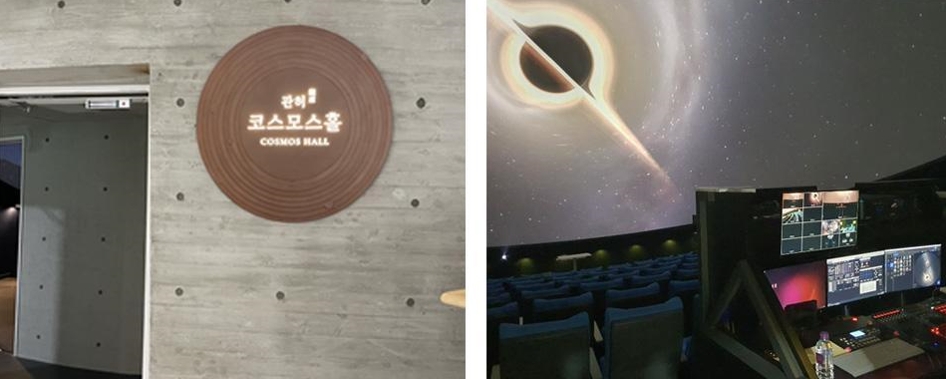The Astronomy Program at Seoul National University has been organizing public events consistently since 1983 as part of the university's social contribution program. The events aim to provide opportunities for many to learn about astronomy. During these events, various in-depth lecture programs are held where researchers in the field deliver the latest astronomical research findings in an easily understandable manner for nonprofessionals.
Both a planetarium and high-tech multimedia space, Cosmos Hall Gwan-heo
Recent public event took place on December 16th (Saturday) at Cosmos Hall Gwan-heo in the College of Natural Sciences Building (Building 28). The event’s theme was "Observing Black Holes: How Do We Do It?" In 2023, a total of six public events were held, including four programs at the planetarium and two programs at SNU Observatory on observing celestial bodies using the 1m telescope.
This time, the event consisted of lectures and a visit to the planetarium. Cosmos Hall Gwan-heo was revived as a high-tech digital projection space in December 2022, after the demolition of the previous planetarium in 2003. It was named Gwan-heo after the pen name of the late Professor Seung-soo Hong, whose generous donation made possible the foundation of the planetarium. Cosmos Hall Gwan-heo not only serves as a planetarium projecting the universe onto the dome-shaped ceiling, but also as a multimedia space, equipped with cutting-edge audio-visual technology to host various programs such as video screenings, lectures, and performances. December’s public event also actively utilized the multimedia capabilities of Cosmos Hall Gwan-heo during its proceedings.

The outside(left) and inside(right) of Cosmos Hall Gwan-heo, at the College of Natural Sciences
Astronomy Program’s public event provides a special experience for the audience
December’s public event was divided into two parts. The first part was a lecture titled "Observing Black Holes," and the second part was an observation session at the planetarium. The lecturer, Changseok Kim (Combined master's/doctoral program, Department of Physics and Astronomy), started off the event stating, "observing black holes is my research area, and I have been curious about how astronomers observe and study invisible celestial bodies such as black holes since I was young. That's why I chose this topic for the lecture." The lecture was filled with specialized knowledge that was well explained to ensure that even nonprofessionals could easily understand. It began with an explanation of the nature of black holes, followed by a detailed discussion of the process of observing and researching black holes. Since it is impossible to directly observe the lights coming from black holes, the presence of black holes has to be inferred by their traces in the surrounding area. Three methods of inferring their presence were introduced during the lecture. In addition, the speaker provided a concise explanation of his ongoing research, as the purpose of the public event was to share the university's research achievements with the community. Kim explained his research saying, "I am studying the impact of the active galactic nucleus on the birth of stars within the galaxy and researching how the active galactic nucleus and the galaxy evolve through this process."

The poster of the public event(left) and a photo taken during the lecture(right)
In the second part of the event that followed, the audience was given time to observe the celestial projections along with the host’s explanations. As the observation began, the interior of the planetarium gradually dimmed, and the enchanting spectacle of the night sky unfolded in all directions, eliciting admiration from the audience. Researcher Hangbin Jo (Combined master's/doctoral program, Department of Physics and Astronomy) took charge of the observation. He sequentially displayed planets such as Saturn and Jupiter, the North Star, and various winter constellations on the dome screen and gave brief explanations for each, enhancing the experience. Three special photo sessions were provided for the audience during the observation. During these photo sessions, the Gemini meteor shower observed at the end of the year, the Milky Way in the summer night sky, and the black holes discussed in the previous lecture were projected. After the observation, the movie "Cosmos Odyssey: The Great Journey Exploring the Universe" directed by O Chul Kwon, was screened. Watching a movie about the history of the universe with the planetarium’s dome screen provided a new cinematic experience for the audience accustomed to flat screens.

The audience is taking pictures of the projected Milky Way
Sunkyun Lee, a middle school student who participated in this event said, "The explanation about black holes was impressive." He added, "observing celestial bodies was fascinating and enjoyable, which helped me ponder more deeply whether this area was within my interest."
The Astronomy Program consistently organizes public events every year, featuring lectures, observatory visits, and planetarium tours, both offline and even online events since 2021. Some of the past events can be found on the planetarium’s YouTube channel, and information about the previous lectures and upcoming event schedules can be accessed by the Astronomy Program’s social contribution website. The public events, which will continue this year, are highly recommended to all those who are interested. A magical encounter with the universe on campus will undoubtedly be an unforgettable and enriching experience.
Astronomy Program’s social contribution website: https://sites.google.com/view/oasnu/%ED%99%88?authuser=0
Written by SNU Student Reporter Sumin Kim (Department of Korean Language and Literature)
47sumin@snu.ac.kr
Translated by Jieun Oh (Department of English Language and Literature)

